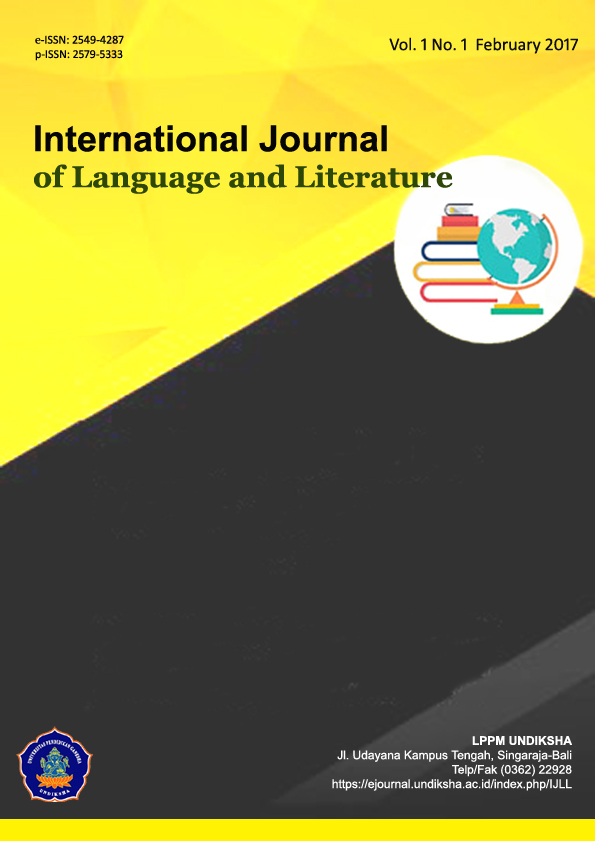PERCEIVED AND OBSERVED TEACHING CREATIVITY OF ENGLISH TEACHERS IN SMKN 1 NEGARA
DOI:
https://doi.org/10.23887/ijll.v4i1.30223Keywords:
21st Century Learning, Teachers Creativity, CreativityAbstract
Teachers’ creativity is an important aspect that has an influential effect on students’ competence, however research on this particular topic is hardly found. This study aimed at investigating teachers’ creativity from two perspectives: From how they perceived and what they implemented in the classroom, and then to describe the discrepancy between the two Embedded mixed method was used as the design of this study which means the qualitative data was dominant than quantitative data QUAL (quan). Two EFL teachers of SMKN 1 Negara were chosen as the subject. Self-rated questionnaire, classroom observation sheet, and in-depth interview were used as the instruments. The discrepancy of two data were occurred. The investigation proves that the teachers rarely teach based on the lesson plan, teach inductively, conduct innovative learning by using technology as learning media. The teachers mainly focused on using same media in several meetings, conduct monotonous teaching activity.
References
Al-Dababneh, & E. K, A.-Z. (2017). Can Teachers’ Self-reported Characteristics and Beliefs about Creativity Predict Their Perception of Their Creativity Practices in the Classroom? International Journal Of Special Education, 32(4), 723–745. https://files.eric.ed.gov/fulltext/EJ1184189.pdf
Al-Juda, M. Q. . (2017). Distance Learning Students ’ Evaluation of E-Learning System in University of Tabuk , Saudi Arabia. Journal of Education and Learning, 6(4), 324–335. https://doi.org/10.5539/jel.v6n4p324 DOI: https://doi.org/10.5539/jel.v6n4p324
Anagün, Ş. S. (2018). Teachers ’ Perceptions about the Relationship between 21st Century Skills and Managing Constructivist Learning Environments. International Journal of Instruction, 11(4), 825–840. DOI: https://doi.org/10.12973/iji.2018.11452a
Anjani, D., Maridi, & Suciati. (2018). Inquiry Based Learning Module to Empower Cooperation Skills. Journal of Education and Learning (EduLearn), 12(2), 172–178. https://doi.org/10.11591/edulearn.v12i2.8268 DOI: https://doi.org/10.11591/edulearn.v12i2.8268
Arifani, Y. (2019). The Influence of Male and Female ESP Teachers’ Creativity toward Learners’ Involvement. International Journal of Instruction, 12(1), 237–250. DOI: https://doi.org/10.29333/iji.2019.12116a
Bedir, H. (2019). Pre-service ELT teachers’ beliefs and perceptions on 21st century learning and innovation skills (4Cs). Journal of Language and Linguistic Studies, 15(1), 231–246. https://doi.org/10.17263/jlls.547718 DOI: https://doi.org/10.17263/jlls.547718
Boden, M. A. (1998). Creativity and Artificial Intelligence. Artificial Intelligence, 103, 347–356. DOI: https://doi.org/10.1016/S0004-3702(98)00055-1
Cayirdag, N. (2017). Creativity Fostering Teaching:Impact of Creative Self-efficacy and Teacher Efficacy. Kuram Ve Uygulamada Eğitim Bilimleri Educational Sciences, 1959–1975. https://doi.org/10.12738/estp.2017.6.0437 DOI: https://doi.org/10.12738/estp.2017.6.0437
Creswell, J. (2012). Planning, Conducting and Evaluating Quantitative and Qualitative Researc. Pearson Education. http://basu.nahad.ir/uploads/creswell.pdf
Deniz, C. T. (2018). Pre-service Teachers’ Opinions about the Use of 21st Century Learner and21st Century Teacher Skills. European Journal of Educational Research, 8(1), 181–197. https://doi.org/10.12973/eu-jer.8.1.181 DOI: https://doi.org/10.12973/eu-jer.8.1.181
Dian, Y., & Limantara, P. (2017). Pengaruh Customer Perception Terhadap Minat Beli Konsumen Melalui Multiattribute Attitude Mode pada Produk Makanan Organik. Jurnal Manajemen Pemasaran, 11(2), 69–77. https://doi.org/10.9744/pemasaran.11.2.69 DOI: https://doi.org/10.9744/pemasaran.11.2.69-78
Etikan, I., Musa, S. A., & Alkassim, R. S. (2016). Comparison of Convenience Sampling and Purposive Sampling Comparison of Convenience Sampling and Purposive Sampling. American Journal of Theoretical and Applied Statistics, 5(1). https://doi.org/10.11648/j.ajtas.20160501.11 DOI: https://doi.org/10.11648/j.ajtas.20160501.11
Fitrah. (2018). The Role of Technology in Teachers’ Creativity Development in English Teaching Practices. TEFLIN Journal, 29(2), 177–193. https://doi.org/http://dx.doi.org/10.15639/teflinjournal.v29i2/177-193 DOI: https://doi.org/10.15639/teflinjournal.v29i2/177-193
Henriksen, D., Henderson, M., Creely, E., Ceretkova, S., Černochová, M., & Sendova, E. (2018). Creativity and Technology in Education: An International Perspective. Technology, Knowledge and Learning, December. https://doi.org/https://doi.org/10.1007/s10758-018-9380-1 DOI: https://doi.org/10.1007/s10758-018-9380-1
Howard, P. G. (2018). Twenty-first century learning as a radical re-thinking of education in the service of life. Education Sciences, 8(4). https://doi.org/10.3390/educsci8040189 DOI: https://doi.org/10.3390/educsci8040189
Indrawan, R., & Yaniawati, P. (2016). Metodologi Penelitian Kuantitatif, Kualitatif dan Campuran untuk Manajemen Pembangunan dan Pendidikan. PT Refika Aditama.
Kinai, T. (2013). Kenyan Student-Teacher Counsellors’ Creativity and Its Relationship with Their Gender, Age, and Teaching Experience. Online Submission, 3(5), 296–304.
O’Keeffe, J., Buytaert, W., Mijic, A., B. N., & Sinha, R. (2016). The use of Semi-structured Interviews for the Characterisation of Farmer Irrigation Practices. Hydrolody and Earth System Sciences, 1911–1924. https://doi.org/10.5194/hess-20-1911-2016 DOI: https://doi.org/10.5194/hess-20-1911-2016
Sujarweni, W. V. (2014). Metode Penelitian: Lengkap, Praktis dan Mudah Dipahami. PUSTAKABARUPRESS.
Wibowo, A., Saptono, A., & Suparno. (2018). Does Teachers’ Creativity Impact On Vocational Students’ Entrepreneurial Intention? Journal of Entrepreneurship Education, 21(3).
Downloads
Published
How to Cite
Issue
Section
License
IJLL Journal provides immediate open access to its content on the principle that making research freely available to the public to supports a greater global exchange of knowledge.

This work is licensed under a Creative Commons Attribution-ShareAlike 4.0 International License







